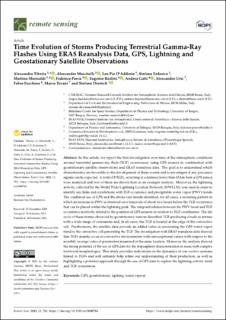| dc.contributor.author | Tiberia, Alessandra | |
| dc.contributor.author | Mascitelli, Alessandra | |
| dc.contributor.author | D’adderio, Leo Pio | |
| dc.contributor.author | Federico, Stefano | |
| dc.contributor.author | Marisaldi, Martino | |
| dc.contributor.author | Porcù, Federico | |
| dc.contributor.author | Realini, Eugenio | |
| dc.contributor.author | Gatti, Andrea | |
| dc.contributor.author | Ursi, Alessandro | |
| dc.contributor.author | Fuschino, Fabio | |
| dc.contributor.author | Tavani, Marco | |
| dc.contributor.author | Dietrich, Stefano | |
| dc.date.accessioned | 2022-04-11T09:04:00Z | |
| dc.date.available | 2022-04-11T09:04:00Z | |
| dc.date.created | 2022-01-19T09:01:13Z | |
| dc.date.issued | 2021 | |
| dc.identifier.issn | 2072-4292 | |
| dc.identifier.uri | https://hdl.handle.net/11250/2990885 | |
| dc.description.abstract | In this article, we report the first investigation over time of the atmospheric conditions around terrestrial gamma-ray flash (TGF) occurrences, using GPS sensors in combination with geostationary satellite observations and ERA5 reanalysis data. The goal is to understand which characteristics are favorable to the development of these events and to investigate if any precursor signals can be expected. A total of 9 TGFs, occurring at a distance lower than 45 km from a GPS sensor, were analyzed and two of them are shown here as an example analysis. Moreover, the lightning activity, collected by the World Wide Lightning Location Network (WWLLN), was used in order to identify any links and correlations with TGF occurrence and precipitable water vapor (PWV) trends. The combined use of GPS and the stroke rate trends identified, for all cases, a recurring pattern in which an increase in PWV is observed on a timescale of about two hours before the TGF occurrence that can be placed within the lightning peak. The temporal relation between the PWV trend and TGF occurrence is strictly related to the position of GPS sensors in relation to TGF coordinates. The life cycle of these storms observed by geostationary sensors described TGF-producing clouds as intense with a wide range of extensions and, in all cases, the TGF is located at the edge of the convective cell. Furthermore, the satellite data provide an added value in associating the GPS water vapor trend to the convective cell generating the TGF. The investigation with ERA5 reanalysis data showed that TGFs mainly occur in convective environments with unexceptional values with respect to the monthly average value of parameters measured at the same location. Moreover, the analysis showed the strong potential of the use of GPS data for the troposphere characterization in areas with complex territorial morphologies. This study provides indications on the dynamics of con-vective systems linked to TGFs and will certainly help refine our understanding of their production, as well as highlighting a potential approach through the use of GPS data to explore the lightning activity trend and TGF occurrences. | en_US |
| dc.language.iso | eng | en_US |
| dc.publisher | MDPI | en_US |
| dc.rights | Navngivelse 4.0 Internasjonal | * |
| dc.rights.uri | http://creativecommons.org/licenses/by/4.0/deed.no | * |
| dc.title | Time evolution of storms producing terrestrial gamma-ray flashes using era5 reanalysis data, gps, lightning and geo-stationary satellite observations | en_US |
| dc.type | Journal article | en_US |
| dc.type | Peer reviewed | en_US |
| dc.description.version | publishedVersion | en_US |
| dc.rights.holder | Copyright 2021 The Author(s) | en_US |
| dc.source.articlenumber | 784 | en_US |
| cristin.ispublished | true | |
| cristin.fulltext | original | |
| cristin.qualitycode | 1 | |
| dc.identifier.doi | 10.3390/rs13040784 | |
| dc.identifier.cristin | 1984279 | |
| dc.source.journal | Remote Sensing | en_US |
| dc.identifier.citation | Remote Sensing. 2021, 13 (4), 784. | en_US |
| dc.source.volume | 13 | en_US |
| dc.source.issue | 4 | en_US |

